Thin-Reinforced Anion-Exchange Membranes with High Ionic Contents for Electrochemical Energy Conversion Processes
Abstract
:1. Introduction
2. Materials and Methods
2.1. Materials
2.2. Fabrication of Reinforced AEMs
2.3. Membrane Characterizations
2.4. RED Performance Test
2.5. VRFB Performance Test
2.6. Overall Dialysis Coefficient of Vanadium Ion
2.7. Chemical Stability Evaluation Tests
3. Results and Discussion
4. Conclusions
Author Contributions
Funding
Institutional Review Board Statement
Data Availability Statement
Acknowledgments
Conflicts of Interest
References
- Zhen, G.; Pan, Y.; Lu, X.; Li, Y.-Y.; Zhang, Z.; Niu, C.; Kumar, G.; Kobayashi, T.; Zhao, Y.; Xu, K. Anaerobic membrane bioreactor towards biowaste biorefinery and chemical energy harvest: Recent progress, membrane fouling and future perspectives. Renew. Sust. Energ. Rev. 2019, 115, 109392. [Google Scholar] [CrossRef]
- Kang, B.; Kim, H.J.; Kim, D.K. Membrane electrode assembly for energy harvesting from salinity gradient by reverse electrodialysis. J. Membr. Sci. 2018, 550, 286–295. [Google Scholar] [CrossRef]
- Veerman, J.; Saakes, M.; Metz, S.J.; Harmsen, G.J. Reverse electrodialysis: Performance of a stack with 50 cells on the mixing of sea and river water. J. Membr. Sci. 2009, 327, 136–144. [Google Scholar] [CrossRef] [Green Version]
- Tawalbeh, M.; Al-Othman, A.; Abdelwahab, N.; Alami, A.H.; Olabi, A.G. Recent developments in pressure retarded osmosis for desalination and power generation. Renew. Sust. Energ. Rev. 2021, 138, 110492. [Google Scholar] [CrossRef]
- Brauns, E. Salinity gradient power by reverse electrodialysis: Effect of model parameters on electrical power output. Desalination 2009, 237, 378–391. [Google Scholar] [CrossRef]
- Güler, E.; Elizen, R.; Vermaas, D.A.; Saakes, M.; Nijmeijer, K. Performance-determining membrane properties in reverse electrodialysis. J. Membr. Sci. 2013, 446, 266–276. [Google Scholar] [CrossRef]
- Hong, J.G.; Chen, Y. Nanocomposite reverse electrodialysis (RED) ion-exchange membranes for salinity gradient power generation. J. Membr. Sci. 2014, 460, 139–147. [Google Scholar] [CrossRef]
- Güler, E.; Baak, W.V.; Saakes, M.; Nijmijer, K. Monovalent-ion-selective membranes for reverse electrodialysis. J. Membr. Sci. 2014, 455, 254–270. [Google Scholar] [CrossRef]
- Sarapulova, V.; Shkorkina, I.; Mareev, S.; Pismenskaya, N.; Kononenko, N.; Larchet., C.; Dammak, L.; Nikonenko., V. Transport characteristics of Fujifilm ion-exchange membranes as compared to homogeneous membranes АМХ and СМХ and to heterogeneous membranes MK-40 and MA-41. Membranes 2019, 9, 84. [Google Scholar] [CrossRef] [Green Version]
- Sun, C.; Negro, E.; Vezzù, K.; Pagot, G.; Cavinato, G.; Nale, A.; Bang, Y.H.; Di Noto, V. Hybrid inorganic-organic proton-conducting membranes based on SPEEK doped with WO3 nanoparticles for application in vanadium redox flow batteries. Electrochem. Acta 2019, 309, 311–325. [Google Scholar] [CrossRef]
- Wang, W.; Luo, Q.; Li, B.; Wei, X.; Li, L.; Yang, Z. Recent progress in redox flow battery research and development. Adv. Funct. Mater. 2013, 23, 970. [Google Scholar] [CrossRef]
- Sun, C.; Negro, E.; Nale, A.; Pagot, G.; Vezzù, K.; Zawodzinski, T.A.; Meda, L.; Gambaro, C.; Di Noto, V. An efficient barrier toward vanadium crossover in redox flow batteries: The bilayer [Nafion/(WO3)x] hybrid inorganic-organic membrane. Electrochem. Acta 2021, 378, 138133. [Google Scholar] [CrossRef]
- Zhang, J.; Jiang, G.; Xu, P.; Kashkooli, A.G.; Mousavi, M.; Yu, A.; Chen, Z. An all-aqueous redox flow battery with unprecedented energy density. Energy Environ. Sci. 2018, 11, 2010–2015. [Google Scholar] [CrossRef]
- Kear, G.; Shah, A.A.; Walsh, F.C. Development of the all-vanadium redox flow battery for energy storage: A review of technological, financial and policy aspects. Int. J. Energy Res. 2012, 36, 1105–1120. [Google Scholar] [CrossRef]
- Yang, Z.; Zhang, J.; Kintner-Meyer, M.C.W.; Lu, X.; Choi, D.; Lemmon, J.P.; Liu, J. Electrochemical energy storage for green grid. Chem. Rev. 2011, 111, 3021. [Google Scholar] [CrossRef] [PubMed]
- Ding, C.; Zhang, H.; Li, X.; Liu, T.; Xing, F. Vanadium flow battery for energy storage: Prospects and challenges. J. Phys. Chem. Lett. 2013, 4, 1281. [Google Scholar] [CrossRef]
- Jiang, B.; Yu, L.; Wu, L.; Mu, D.; Liu, L.; Xi, J.; Qiu, X. Insights into the impact of the Nafion membrane pretreatment process on vanadium flow battery Performance. ACS Appl. Mater. Interfaces 2016, 8, 12228. [Google Scholar] [CrossRef]
- Chieng, S.C.; Kazacos, M.; Kazacos, M.S. Preparation and evaluation of composite membrane for vanadium redox battery application. J. Power Sources 1992, 39, 11. [Google Scholar] [CrossRef]
- Ahn, Y.; Kim, D. Ultra-low vanadium ion permeable electrolyte membrane for vanadium redox flow battery by pore filling of PTFE substrate. Energy Storage Mater. 2020, 31, 105–114. [Google Scholar] [CrossRef]
- Zhang, D.; Xu, Z.; Zhang, X.; Zhao, L.; Zhao, Y.; Wang, S.; Liu, W.; Che, X.; Yang, J.; Liu, J.; et al. Oriented proton-conductive nanochannels boosting a highly conductive proton-exchange membrane for a vanadium redox flow battery. ACS Appl. Mater. Interfaces 2021, 13, 4051–4061. [Google Scholar] [CrossRef]
- Rajput, A.; Khan, H.; Raj, S.K.; Kothandaraman, R.; Kulshrestha, V. Styrene-co-DVB grafted PVDF proton exchange membranes for vanadium redox flow battery applications. Mater. Adv. 2020, 1, 1930–1938. [Google Scholar] [CrossRef]
- Chen, D.; Hickner, M.A.; Agar, E.; Kumbur, E.C. Optimized anion exchange membranes for vanadium redox flow batteries. ACS Appl. Mater. Interfaces 2013, 5, 7559. [Google Scholar] [CrossRef]
- Wang, T.; Jeon, J.Y.; Han, J.; Kim, J.H.; Bae, C.; Kim, S. Poly(terphenylene) anion exchange membranes with high conductivity and low vanadium permeability for vanadium redox flow batteries (VRFBs). J. Membr. Sci. 2020, 598, 117665. [Google Scholar] [CrossRef]
- Zhang, B.; Zhao, M.; Liu, Q.; Zhang, X.; Fu, Y.; Zhang, E.; Wang, G.; Zhang, Z.; Zhang, S. Advanced anion exchange membranes with selective swelling-induced ion transport channels for vanadium flow battery application. J. Membr. Sci. 2022, 642, 119985. [Google Scholar] [CrossRef]
- Yamaguchi, T.; Nakao, S.; Kimura, S. Plasma-graft filling polymerization: Preparation of a new type of pervaporation membrane for organic liquid mixtures. Macromolecules 1991, 24, 5522–5527. [Google Scholar] [CrossRef]
- Yamaguchi, T.; Miyata, F.; Nakao, S. Pore-filling type polymer electrolyte membranes for a direct methanol fuel cell. J. Membr. Sci. 2003, 214, 283–292. [Google Scholar] [CrossRef]
- Kim, D.-H.; Park, J.-S.; Choun, M.; Lee, J.; Kang, M.-S. Pore-filled anion-exchange membranes for electrochemical energy conversion applications. Electrochim. Acta 2016, 222, 212–220. [Google Scholar] [CrossRef]
- Kim, D.-H.; Kang, M.-S. Preparation and characterizations of ionomer-coated pore-filled ion-exchange membranes for reverse electrodialysis. Membr. J. 2016, 26, 43–54. [Google Scholar] [CrossRef]
- Kim, D.-H.; Park, J.-S.; Kang, M.-S. Controlling water splitting characteristics of anion-exchange membranes by coating imidazolium polymer. Membr. J. 2015, 25, 152–161. [Google Scholar] [CrossRef]
- Seo, S.-J.; Kim, B.-C.; Sung, K.-W.; Shim, J.; Jeon, J.-D.; Shin, K.-H.; Shin, S.-H.; Yun, S.-H.; Lee, J.-Y.; Moon, S.-H. Electrochemical properties of pore-filled anion exchange membranes and their ionic transport phenomena for vanadium redox flow battery applications. J. Membr. Sci. 2013, 428, 17–23. [Google Scholar] [CrossRef]
- Wei, W.; Zhang, H.; Li, X.; Mai, Z.; Zhang, H. Poly(tetrafluoroethylene) reinforced sulfonated poly(ether ether ketone) membranes for vanadium redox flow battery application. J. Power Sources 2012, 208, 421–425. [Google Scholar] [CrossRef]
- Yang, S.C.; Choi, Y.-W.; Choi, J.; Jeong, N.; Kim, H.; Nam, J.-Y.; Jeong, H. R2R fabrication of pore-filling cation-exchange membranes via one-time impregnation and their application in reverse electrodialysis. ACS Sustainable Chem. Eng. 2019, 7, 12200–12213. [Google Scholar] [CrossRef]
- Lee, Y.J.; Cha, M.S.; Oh, S.-G.; So, S.; Kim, T.-H.; Ryoo, W.S.; Hong, Y.T.; Lee, J.Y. Reinforced anion exchange membrane based on thermal cross-linking method with outstanding cell performance for reverse electrodialysis. RSC Adv. 2019, 9, 27500–27509. [Google Scholar] [CrossRef] [Green Version]
- Hagesteijn, K.F.L.; Jiang, S.; Ladewig, B.P. A review of the synthesis and characterization of anion exchange membranes. J. Mater. Sci. 2018, 53, 11131–11150. [Google Scholar] [CrossRef] [Green Version]
- Hink, S.; Henkensmeier, D.; Jang, J.H.; Kim, H.-J.; Han, J.; Nam, S.-W. Reduced In-Plane Swelling of Nafion by a Biaxial Modification Process. Macromol. Chem. Phys. 2015, 216, 1235–1243. [Google Scholar] [CrossRef]
- Gomez-Coma, L.; Ortiz-Martínez, V.M.; Carmona, F.J.; Palacio, L.; Prádanos, P.; Fallanza, M.; Ortiz, A.; Ibañez, R.; Ortiz, I. Modeling the influence of divalent ions on membrane resistance and electric power in reverse electrodialysis. J. Membr. Sci. 2019, 592, 117385. [Google Scholar] [CrossRef]
- Kim, D.-H.; Choi, Y.-E.; Park, J.-S.; Kang, M.-S. Development and application of cation-exchange membranes including chelating resin for efficient heavy-metal ion removal. Membr. J. 2017, 27, 129–137. [Google Scholar] [CrossRef]
- Kim, D.-H.; Park, J.-H.; Seo, S.-J.; Park, J.-S.; Jung, S.; Kang, Y.S.; Choi, J.-H.; Kang, M.-S. Development of thin anion-exchange pore-filled membranes for high diffusion dialysis performance. J. Membr. Sci. 2013, 447, 80–86. [Google Scholar] [CrossRef]
- Geise, G.M.; Cassady, H.J.; Paul, D.R.; Logan, B.E.; Hickner, M.A. Specific ion effects on membrane potential and the permselectivity of ion exchange membranes. Phys. Chem. 2014, 16, 21673–21681. [Google Scholar] [CrossRef]
- Moon, H.-N.; Song, H.-B.; Kang, M.-S. Thin reinforced ion-exchange membranes containing fluorine moiety for all-vanadium redox flow battery. Membranes 2021, 11, 867. [Google Scholar] [CrossRef]
- Palatý, Z.; Bendová, H. Numerical error analysis of mass transfer measurements in batch dialyzer. Desalination Water Treat. 2011, 26, 215–225. [Google Scholar] [CrossRef]
- Kim, S.; Tighe, T.B.; Schwenzer, B.; Yan, J.; Zhang, J.; Liu, J.; Yang, Z.; Hickner, M.A. Chemical and mechanical degradation of sulfonated poly(sulfone) membranes in vanadium redox flow batteries. J. Appl. Electrochem. 2011, 41, 1201–1213. [Google Scholar] [CrossRef]
- Jeong, S.K.; Lee, J.S.; Woo, S.H.; Seo, J.A.; Min, B.R. Characterization of anion exchange membrane containing epoxy ring and C–Cl bond quaternized by various amine groups for application in fuel cells. Energies 2015, 8, 7084–7099. [Google Scholar] [CrossRef] [Green Version]
- Ezzeldin, H.A.; Apblett, A.; Foutch, G.L. Synthesis and properties of anion exchangers derived from chloromethyl styrene codivinylbenzene and their use in water treatment. Int. J. Polym. Sci. 2010, 684051. [Google Scholar] [CrossRef]
- Mohammed, Y.A.Y.A.; Ma, F.; Liu, L.; Zhang, C.; Dong, H.; Wang, Q.; Xu, X.; Al-Wahbi, A.A. Preparation of electrospun polyvinylidene fluoride/amidoximized polyacrylonitrile nanofibers for trace metal ions removal from contaminated water. J. Porous Mater. 2021, 28, 383–392. [Google Scholar] [CrossRef]
- Jheng, L.-C.; Hsu, C.-Y.; Yeh, H.-Y. Anion exchange membranes based on imidazoline quaternized polystyrene copolymers for fuel cell applications. Membranes 2021, 11, 901. [Google Scholar] [CrossRef]
- Qaisrani, N.A.; Ma, Y.; Ma, L.; Liu, J.; Gao, L.; Li, L.; Gong, S.; Yan, X.; Zhang, F.; He, G. Facile and green fabrication of polybenzoxazine-based composite anion-exchange membranes with a self-cross-linked structure. Ionics 2018, 24, 3053–3063. [Google Scholar] [CrossRef]
- Son, T.Y.; Kim, T.-H.; Nam, S.Y. Crosslinked pore-filling anion exchange membrane using the cylindrical centrifugal force for anion exchange membrane fuel cell system. Polymers 2020, 12, 2758. [Google Scholar] [CrossRef]
- Lei, M.; Zhang, Q.; Chi, M.; Yu, Y.; Jiang, H.; Wang, S.; Min, D. Anion exchange membrane with high hydroxide ion conductivity and robust tensile strength fabricated from quaternary ammonia functionalized Pinus contorta, Dougl. Chip. Ind. Crops. Prod. 2021, 166, 113458. [Google Scholar] [CrossRef]
- Lee, K.H.; Cho, D.H.; Kim, Y.M.; Moon, S.J.; Seong, J.G.; Shin, D.W.; Sohn, J.-Y.; Kim, J.F.; Lee, Y.M. Highly conductive and durable poly(arylene ether sulfone) anion exchange membrane with end-group cross-linking. Energy Environ. Sci. 2017, 10, 275–285. [Google Scholar] [CrossRef]
- Haq, O.U.; Choi, J.-H.; Lee, Y.-S. Anion-exchange membrane for membrane capacitive deionization prepared via pore-filling polymerization in a porous polyethylene supporting membrane. React. Funct. Polym. 2018, 132, 36–42. [Google Scholar] [CrossRef]
- Gayton, J.N.; Autry, S.; Fortenberry, R.C.; Hammer, N.I.; Delcamp, J.H. Counter anion effect on the photophysical properties of emissive indolizine-cyanine dyes in solution and solid state. Molecules 2018, 23, 3051. [Google Scholar] [CrossRef] [PubMed] [Green Version]
- Hren, M.; Božič, M.; Fakin, D.; Kleinschek, K.S.; Gorgieva, S. Alkaline membrane fuel cells: Anion exchange membranes and fuels. Sustain. Energy Fuels 2021, 5, 604–637. [Google Scholar] [CrossRef]
- Pintossi, D.; Chen, C.-L.; Saakes, M.; Nijmeijer, K.; Borneman, Z. Influence of sulfate on anion exchange membranes in reverse electrodialysis. npj Clean Water 2020, 3, 29. [Google Scholar] [CrossRef]
- Chakrabarty, T.; Rajesh, A.M.; Jasti, A.; Thakur, A.K.; Singh, A.K.; Prakash, S.; Kulshrestha, V.; Shahi, V.K. Stable ion-exchange membranes for water desalination by electrodialysis. Desalination 2011, 282, 2–8. [Google Scholar] [CrossRef]
- Maurya, S.; Shin, S.-H.; Kim, Y.; Moon, S.-H. A review on recent developments of anion exchange membranes for fuel cells and redox flow batteries. RSC Adv. 2015, 5, 37206. [Google Scholar] [CrossRef]
- Lee, M.S.; Kang, H.G.; Jeon, J.D.; Choi, Y.W.; Yoon, Y.G. Novel amphoteric ion-exchange membrane prepared by the pore-filling technique for vanadium redox flow batteries. RSC Adv. 2016, 6, 63023–63029. [Google Scholar] [CrossRef]
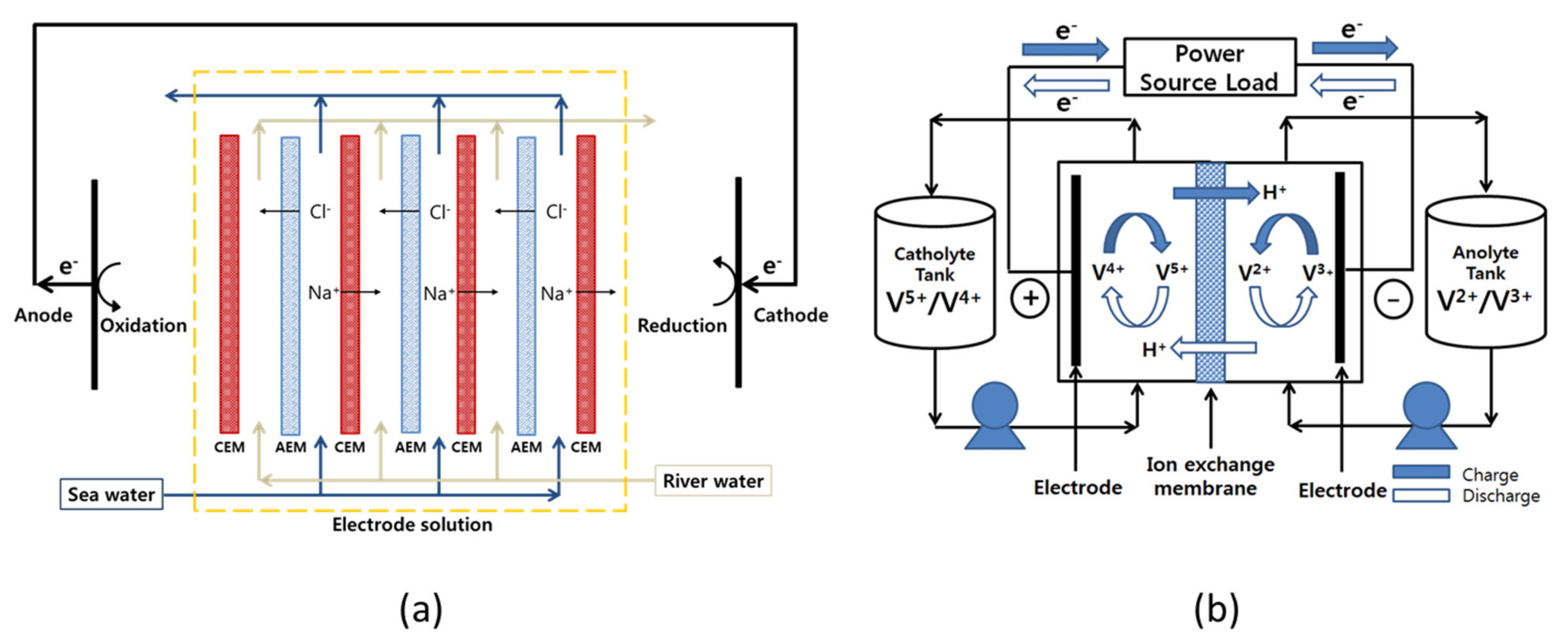
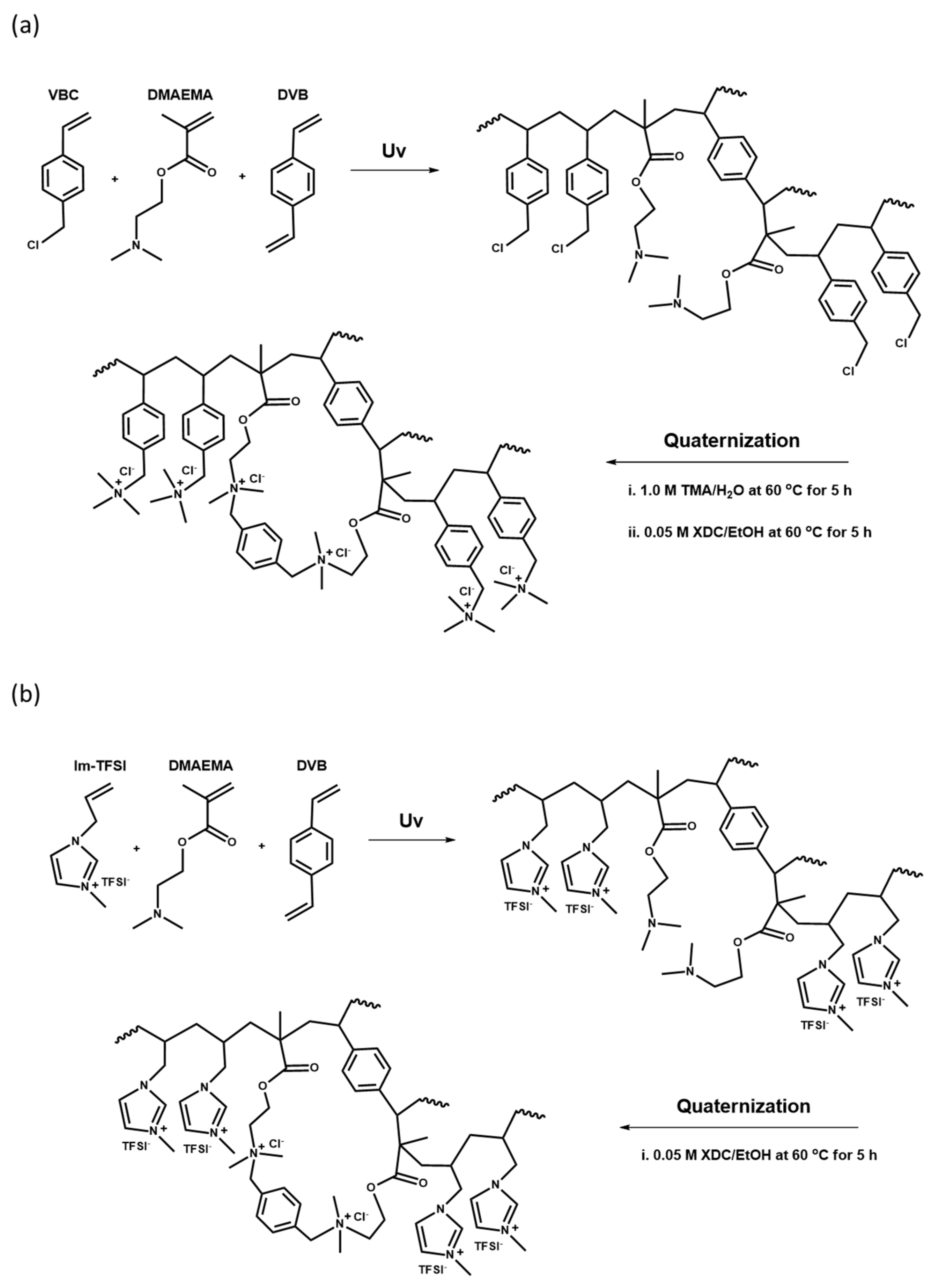
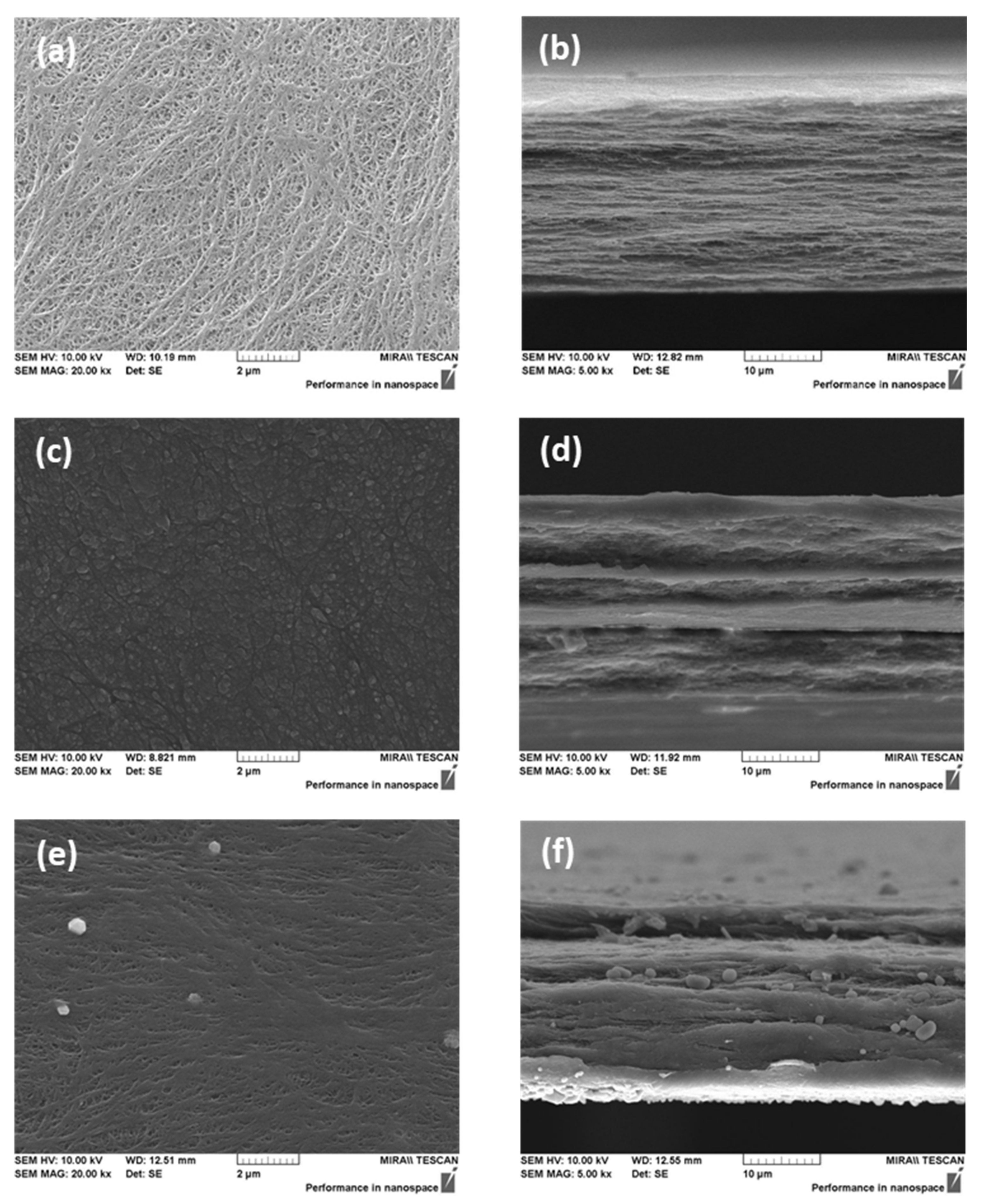
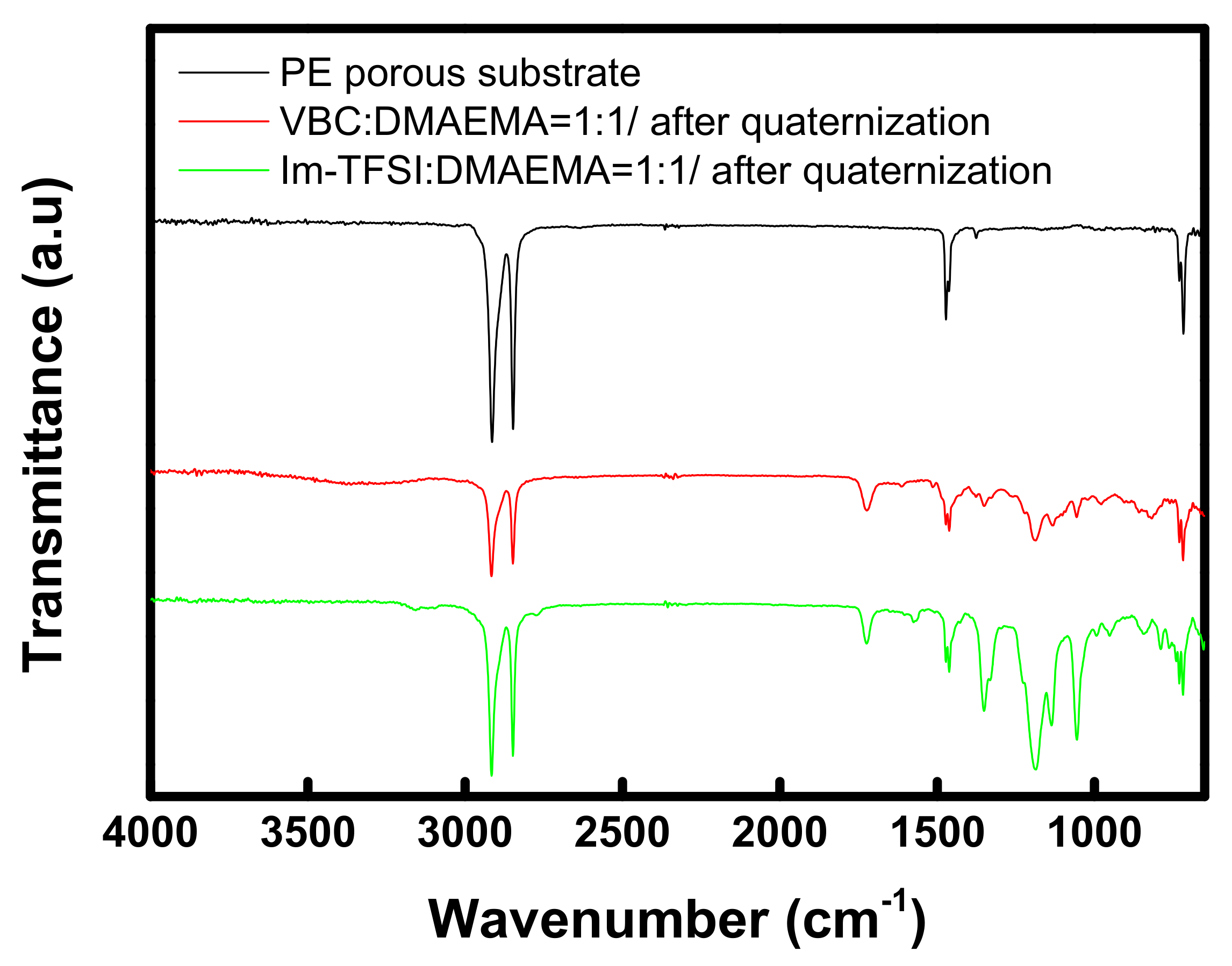
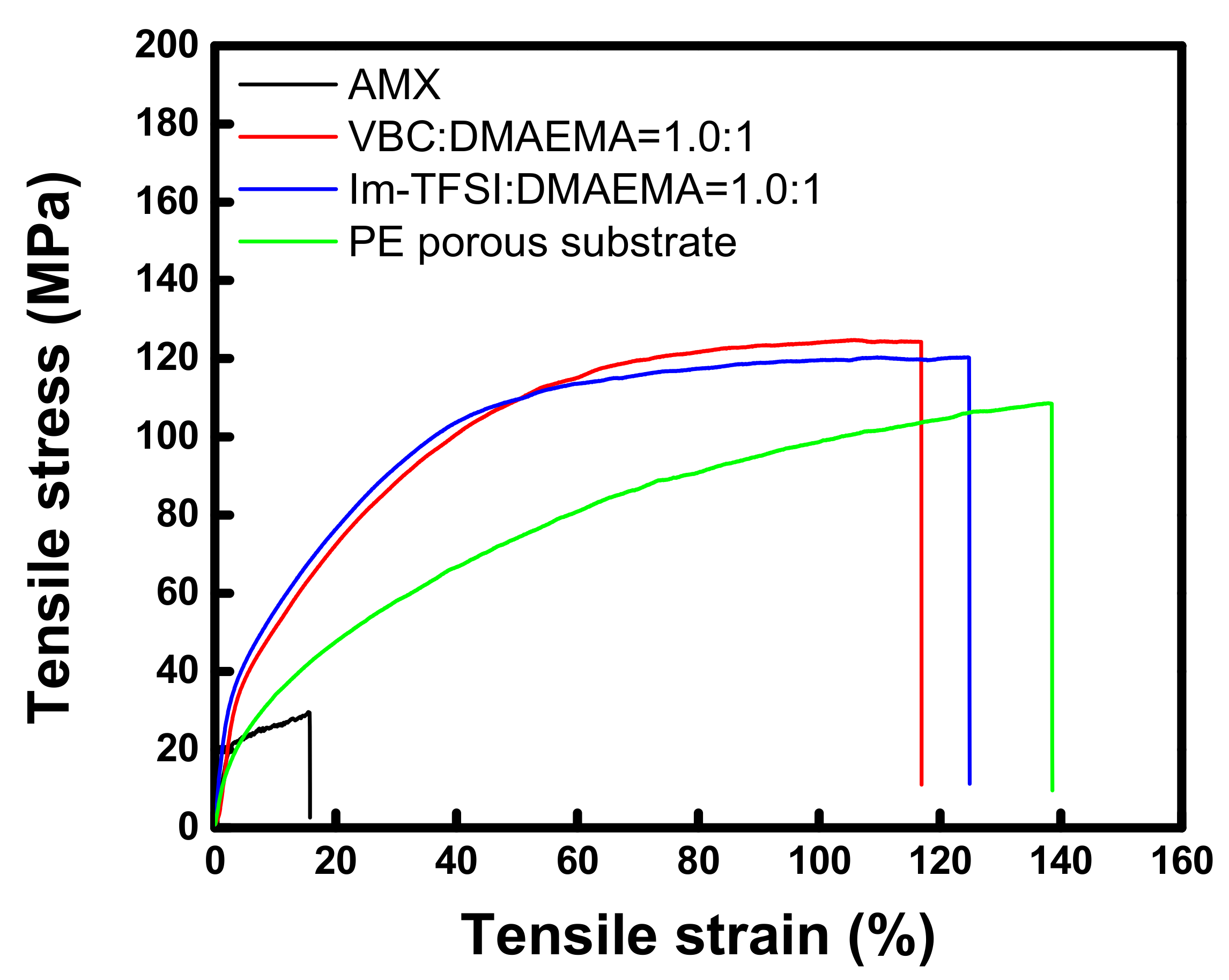
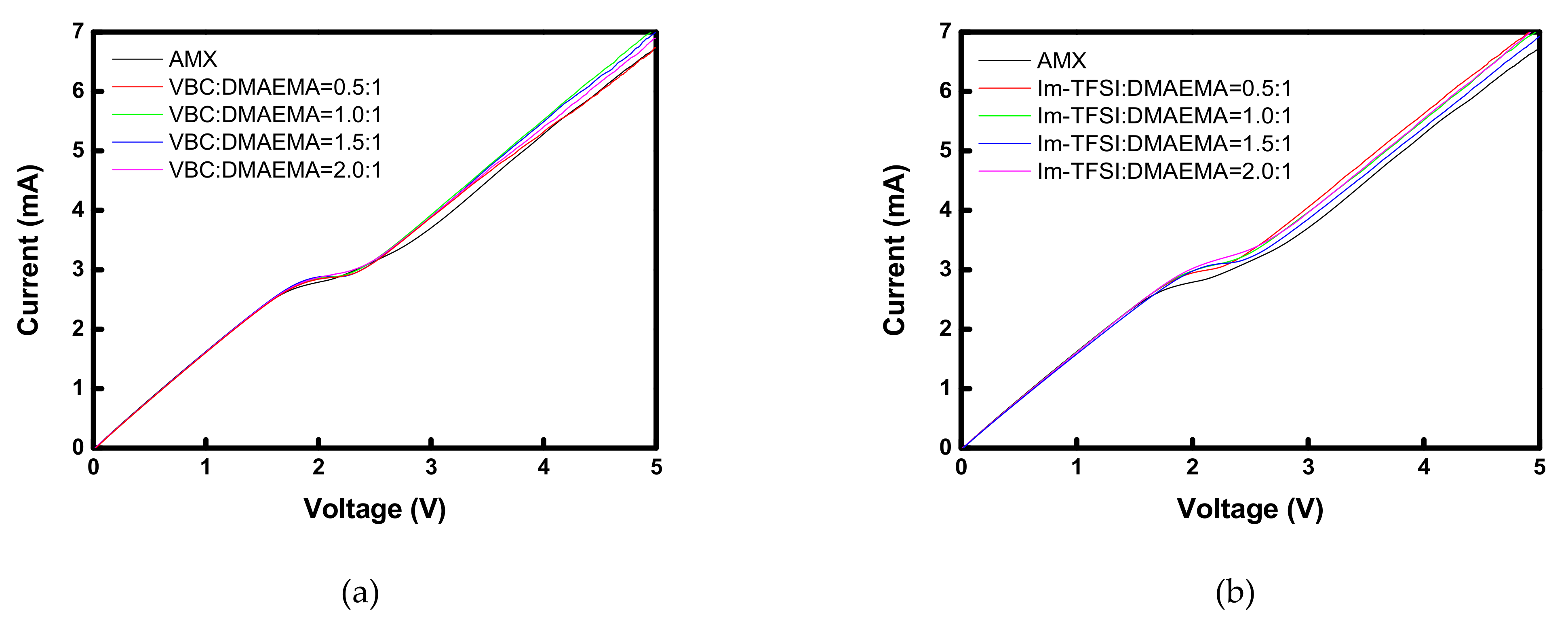
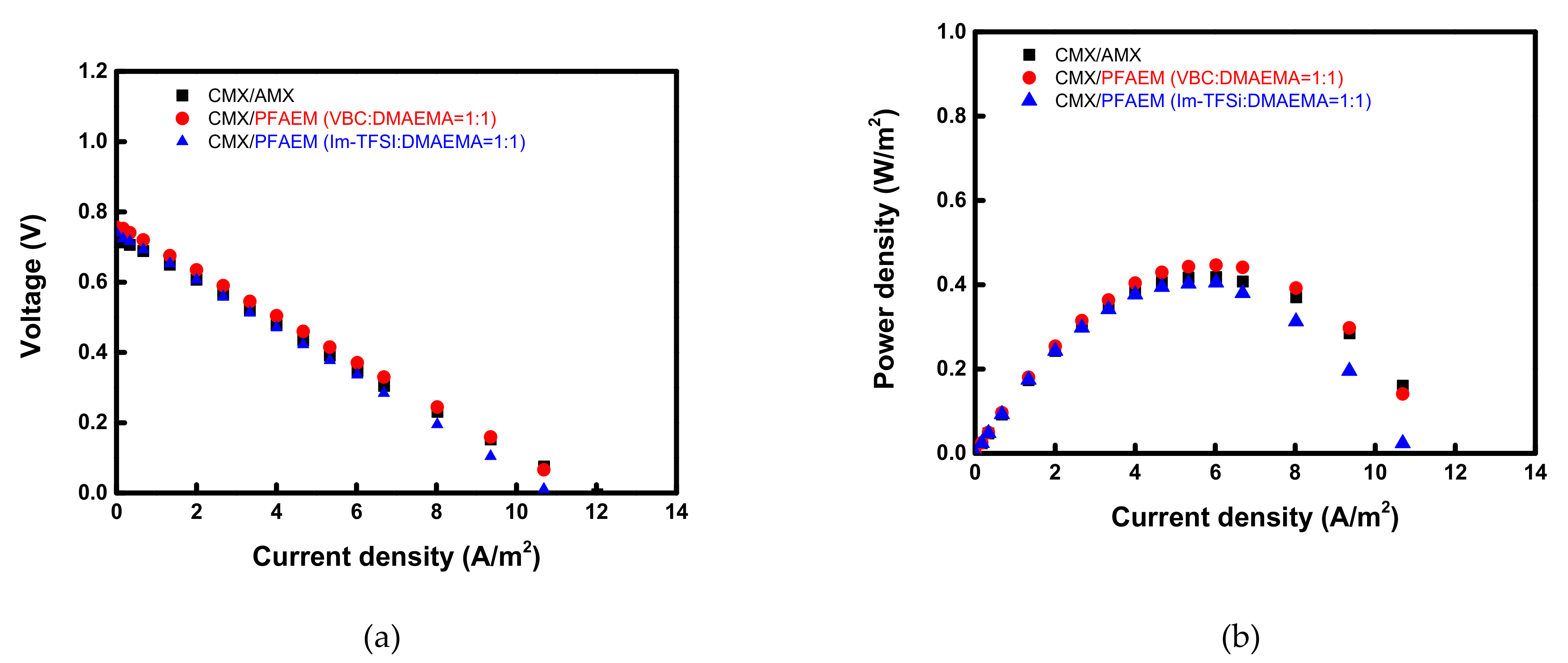
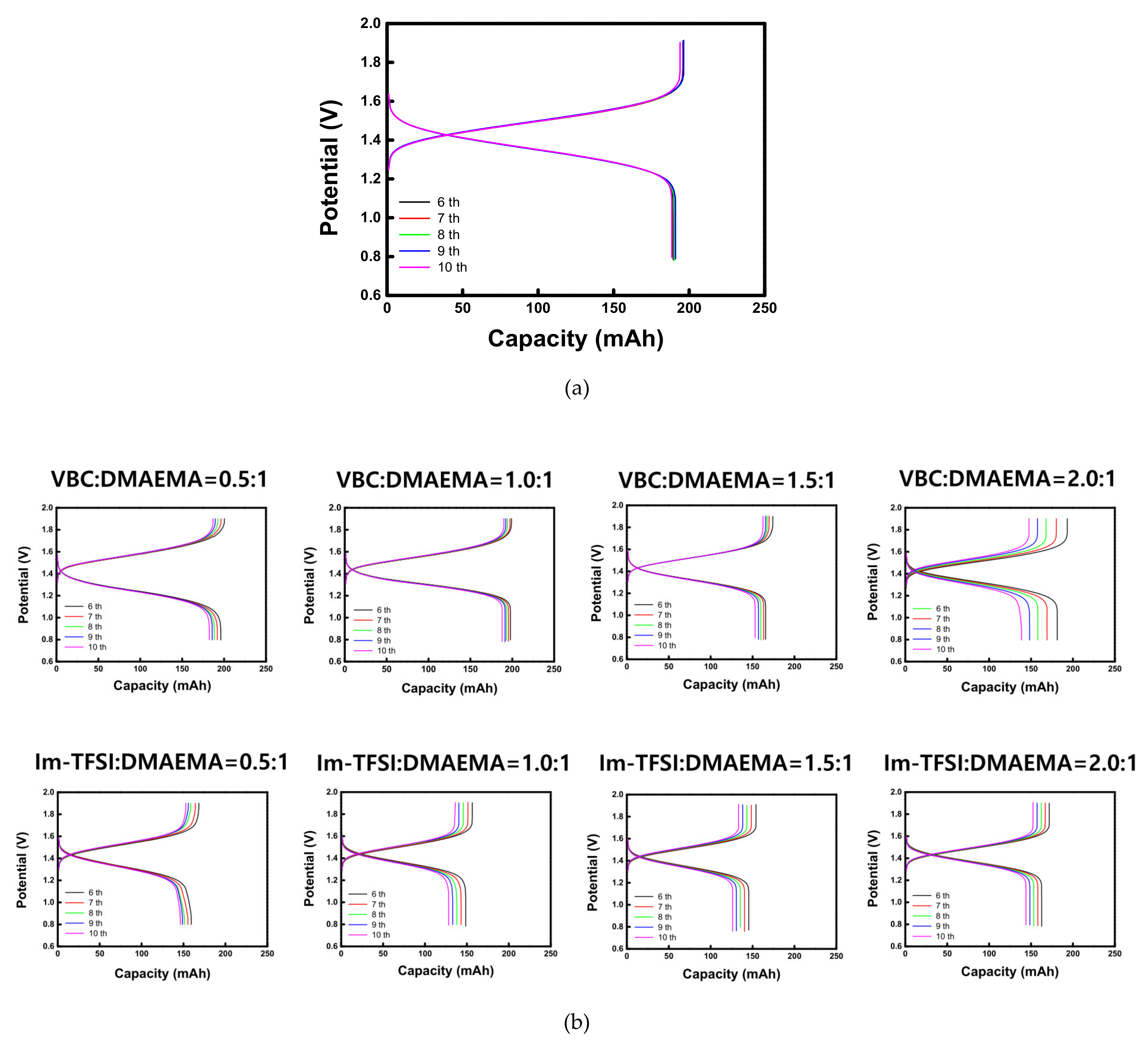
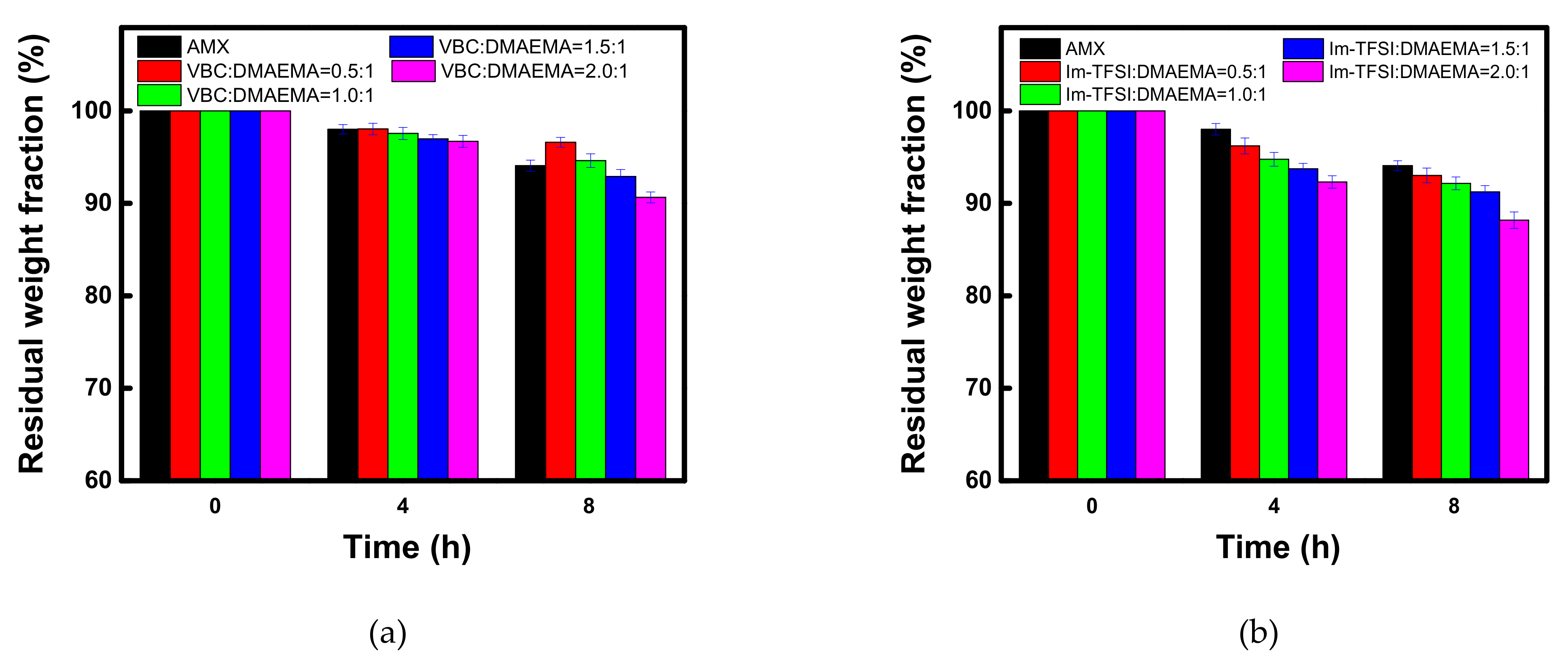
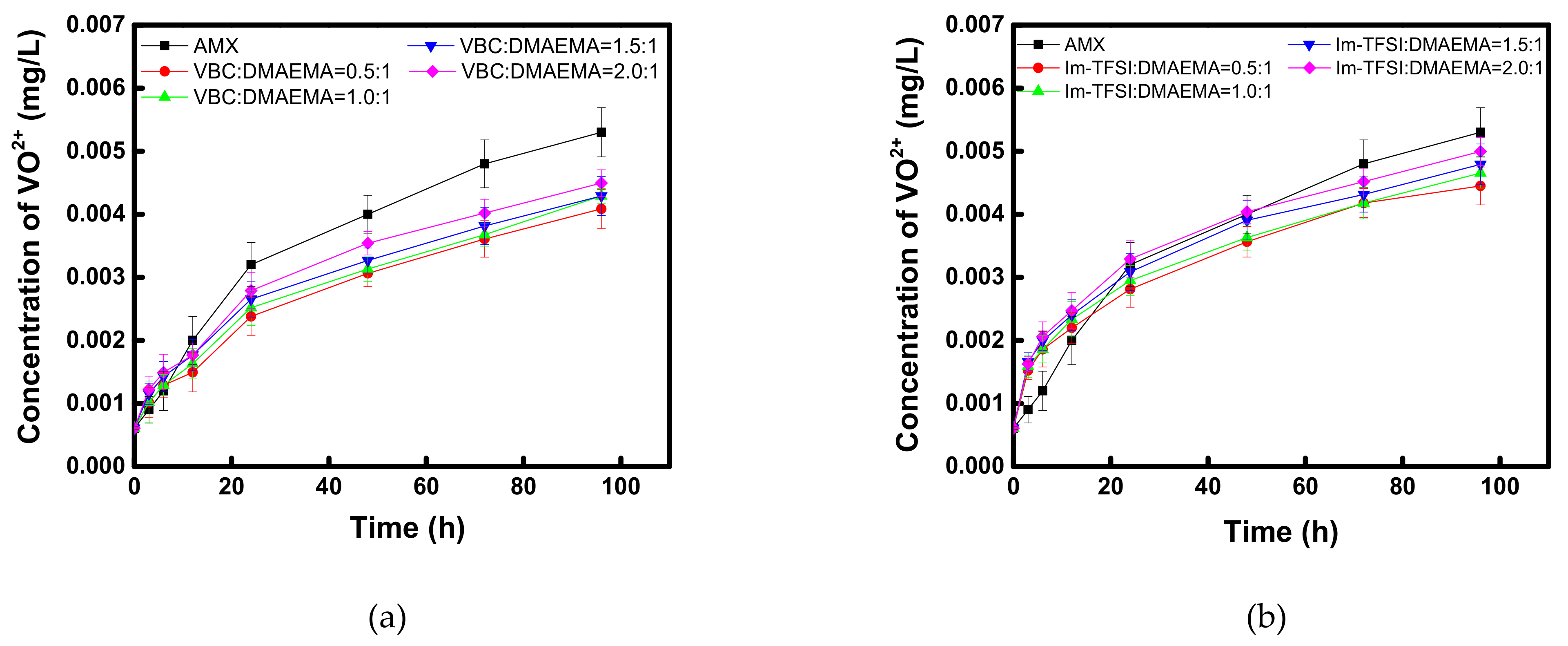
| Membrane | Tensile Strength (MPa) | Elongation at Break (%) |
|---|---|---|
| AMX (Astom Corp.) | 29.47 | 15.60 |
| VBC:DMAEMA=1.0:1/DVB0.10 | 124.3 | 116.9 |
| Im-TFSI:DMAEMA=1.0:1/DVB0.10 | 120.2 | 124.8 |
| PE porous substrate | 108.5 | 138.4 |
| Membrane | Thickness (μm) | VSR (%) | WU (%) | IEC (meq./g) | ER (Ω·cm2) | Transport Number (-) |
|---|---|---|---|---|---|---|
| AMX | 136 | 16.8 | 28.0 | 1.40 | 2.30 | 0.97 |
| VBC:DMAEMA = 0.5:1/DVB0.10 | 24 | 9.67 | 17.0 | 1.95 | 1.25 | 0.97 |
| VBC:DMAEMA = 1.0:1/DVB0.10 | 24 | 11.1 | 17.9 | 2.06 | 0.93 | 0.97 |
| VBC:DMAEMA = 1.5:1/DVB0.10 | 24 | 11.7 | 18.1 | 2.16 | 0.86 | 0.96 |
| VBC:DMAEMA = 2.0:1/DVB0.10 | 25 | 13.1 | 18.2 | 2.42 | 0.54 | 0.95 |
| Im-TFSI:DMAEMA = 0.5:1/DVB0.10 | 24 | 16.7 | 26.9 | 1.74 | 1.81 | 0.96 |
| Im-TFSI:DMAEMA = 1.0:1/DVB0.10 | 25 | 17.4 | 27.1 | 1.95 | 1.61 | 0.96 |
| Im-TFSI:DMAEMA = 1.5:1/DVB0.10 | 25 | 18.0 | 29.2 | 2.08 | 1.40 | 0.96 |
| Im-TFSI:DMAEMA = 2.0:1/DVB0.10 | 25 | 19.4 | 30.9 | 2.25 | 1.34 | 0.95 |
| Membranes | Average Permselectivity, α (-) | OCV (V) | Power Density (W/m2, /Cell Pair) |
|---|---|---|---|
| CMX/AMX | 0.831 | 0.732 | 0.418 |
| CMX/VBC:DMAEMA = 1.0:1/DVB0.10 | 0.881 | 0.756 | 0.446 |
| CMX/Im-TFSI:DMAEMA = 1.0:1/DVB0.10 | 0.872 | 0.740 | 0.404 |
| Membranes | CE (%) | VE (%) | EE (%) | (×10−7, m/s) |
|---|---|---|---|---|
| AMX | 96.2 | 84.0 | 80.8 | 1.92 |
| VBC:DMAEMA = 0.5:1/DVB0.10 | 98.0 | 85.6 | 83.9 | 1.74 |
| VBC:DMAEMA = 1.0:1/DVB0.10 | 99.3 | 88.0 | 87.4 | 1.69 |
| VBC:DMAEMA = 1.5:1/DVB0.10 | 97.3 | 88.5 | 86.1 | 1.89 |
| VBC:DMAEMA = 2.0:1/DVB0.10 | 94.6 | 90.5 | 85.6 | 2.01 |
| Im-TFSI:DMAEMA = 0.5:1/DVB0.10 | 95.6 | 78.0 | 74.6 | 1.84 |
| Im-TFSI:DMAEMA = 1.0:1/DVB0.10 | 94.6 | 82.9 | 78.4 | 1.94 |
| Im-TFSI:DMAEMA = 1.5:1/DVB0.10 | 94.3 | 85.6 | 80.7 | 2.02 |
| Im-TFSI:DMAEMA = 2.0:1/DVB0.10 | 93.5 | 85.9 | 80.3 | 2.15 |
| Membranes | Residual Weight Fraction (%) | |
|---|---|---|
| 4 h | 8 h | |
| AMX | 98.0 | 94.1 |
| VBC:DMAEMA=0.5:1/DVB0.10 | 98.0 | 96.6 |
| VBC:DMAEMA=1.0:1/DVB0.10 | 97.6 | 94.6 |
| VBC:DMAEMA=1.5:1/DVB0.10 | 97.0 | 92.9 |
| VBC:DMAEMA=2.0:1/DVB0.10 | 96.7 | 90.7 |
| Im-TFSI:DMAEMA=0.5:1/DVB0.10 | 96.2 | 93.0 |
| Im-TFSI:DMAEMA=1.0:1/DVB0.10 | 94.8 | 92.2 |
| Im-TFSI:DMAEMA=1.5:1/DVB0.10 | 93.7 | 91.2 |
| Im-TFSI:DMAEMA=2.0:1/DVB0.10 | 92.3 | 88.2 |
Publisher’s Note: MDPI stays neutral with regard to jurisdictional claims in published maps and institutional affiliations. |
© 2022 by the authors. Licensee MDPI, Basel, Switzerland. This article is an open access article distributed under the terms and conditions of the Creative Commons Attribution (CC BY) license (https://creativecommons.org/licenses/by/4.0/).
Share and Cite
Song, H.-B.; Kim, D.-H.; Kang, M.-S. Thin-Reinforced Anion-Exchange Membranes with High Ionic Contents for Electrochemical Energy Conversion Processes. Membranes 2022, 12, 196. https://doi.org/10.3390/membranes12020196
Song H-B, Kim D-H, Kang M-S. Thin-Reinforced Anion-Exchange Membranes with High Ionic Contents for Electrochemical Energy Conversion Processes. Membranes. 2022; 12(2):196. https://doi.org/10.3390/membranes12020196
Chicago/Turabian StyleSong, Hyeon-Bee, Do-Hyeong Kim, and Moon-Sung Kang. 2022. "Thin-Reinforced Anion-Exchange Membranes with High Ionic Contents for Electrochemical Energy Conversion Processes" Membranes 12, no. 2: 196. https://doi.org/10.3390/membranes12020196
APA StyleSong, H.-B., Kim, D.-H., & Kang, M.-S. (2022). Thin-Reinforced Anion-Exchange Membranes with High Ionic Contents for Electrochemical Energy Conversion Processes. Membranes, 12(2), 196. https://doi.org/10.3390/membranes12020196








